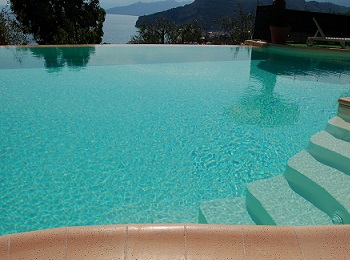
SWIMMING POOL PAINTS
Swimming pool paints: what to apply?
The painting of a concrete swimming pool must be able to combine five different requirements at the same time:
1) Good water resistance
2) Good chemical resistance
3) Good resistance to the development of algae and fungi
4) Ease of application
5) Speed in the drying phase
Colgom, for over 35 years, has been producing ANTIDRIS pool paints based on plasticised chlorinated rubber, which fully satisfy all these needs.
The choice of the most suitable pool paint depends a lot on the construction method.
For swimming pool with a waterproof membrane outside, the best results are obtained by applying low PVC enamels directly.
The term “PVC” (Pigment Value concentration) means the concentration of the volume “fillers + pigment” on the total volume of the product “fillers + pigment + dry resin”.
A product with low PVC is a product with a prevalence of resin and therefore the pigment particles are all surrounded by the binder forming a continuous and densely cross-linked layer.
A product with high PVC the formation of a continuous and homogeneous film instead encounters greater difficulties because it increases the pigment/binder ratio per unit of volume.
Generally, protective enamels for concrete as well as elastomeric coatings are characterized by a low PVC value, while interior paints, breathable, cementitious, etc … from a higher PVC value.
For swimming pool without waterproof barrier on the contact surface between the concrete and the ground, a different cycle is suggested: an epoxy polyamide anchoring primer with a barrier effect and to follow the low PVC finish.
Colgom has made EPICOL TRANSPARENT, an epoxy-polyamide anchoring primer which is an excellent impregnating agent suitable for anchoring hands with an epoxy, acrylic and chlorinated rubber finish.
Directions for a new swimming pool
The structure must not be painted before at least two weeks to allow complete cement maturation.
Next it is advisable to wash the surface to be painted well, first with diluted hydrochloric acid (5%) and then with plenty of water.
The concrete needs to be completely dry before painting.
The first coat – two-component epoxy-polyamide anchoring primer – it is advisable to apply it with a brush to facilitate penetration into the cement support.
The successive enamel coats (two, crossed and spaced 12 hours apart) can be applied by brush or roller.
Recommended final total thickness not less than 50 – 75mµ dry film.
Finally let the pool dry at least 7/8 days before filling it with water.
Directions for swimming pool maintenance
For maintenance interventions, normally biennial except for special needs, the old paint possibly vesiculated or in phase of detachment must be mechanically removed; next clean carefully the surfaces with suitable detergents to eliminate fat and algae deposits.
The damaged areas must be touch up with an anchoring primer and next coat of paint before applying a further finishing coat on the entire surface.
It is always advisable to leave the pool full even during the winter or non-use months